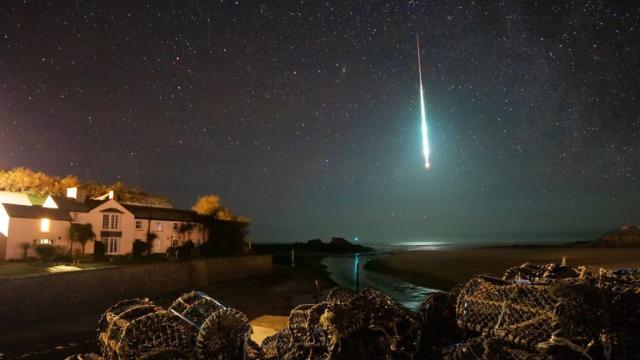Check out this incredible photo of a streaking fireball, which appeared over England last week.
The photo, captured by Christopher Small, was taken in Bude, a seaside resort town in northeast Cornwall, England, reports the European Space Association (ESA). The stunning sight appeared 36 minutes before the stroke of midnight on January 21, 2020.
The meteor was so bright that it lit up the Atlantic surface and the lobster traps in the foreground. The event was spotted by at least five skywatchers, including an observer as far away as London, as chronicled by the International Meteor Organisation.
The term “fireball” may seem fanciful, but it’s a bona fide astronomical designation. Fireballs are classified by the American Meteor Society as “a very bright meteor, generally brighter than magnitude -4,” which is the same brightness as Venus in the morning or night sky.
Some meteors (not this one) have the added notoriety of being classified as bolides. That’s a special type of meteor that explodes during entry through the Earth’s atmosphere, after which its fragments fall down onto the surface. The Chelyabinsk meteor is a notable bolide in recent memory; it famously exploded above Russia on February 15, 2013.
Meteors aren’t anything particularly special, and most of us have managed to see these so-called “falling stars” with our own eyes. According to the ESA, our planet accumulates celestial material to the tune of 54 metric tons (59.5 U.S. tons) each year, arriving as interplanetary dust, meteoroids (objects smaller than 1 metre), and asteroids (objects bigger than 1 metre). Hundreds of fireballs strike Earth each year, according to the ESA. This particular fireball appears to have been a big meteoroid, possibly reaching a full metre in width.
Small, who took the image, told the ESA that he spends a lot of time photographing the night sky, but he’s never seen anything quite like this. The fireball “was incredible, and lit up the entire coast almost as bright as daytime for a few seconds,” he said. “There were beautiful green and blue colours.”
[referenced url=” thumb=” title=” excerpt=”]
That vivid greenish-blue tinge of the fireball and its streak can be attributed to oxygen atoms in the sky, which were “excited” by the heat emanating from the incoming meteor. This caused the oxygen atoms to glow in shades of green and blue, in a process similar to how charged particles from the Sun cause auroras”including the newly discovered green auroral form dubbed “the dunes.”
You can check out more photos from Christopher Small at his website, Ocean and Earth Photography.
